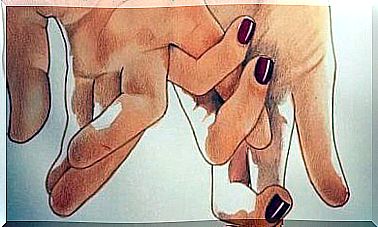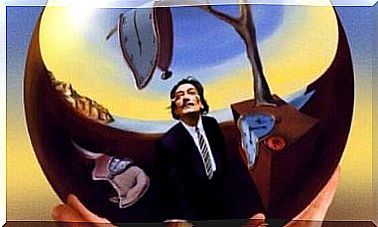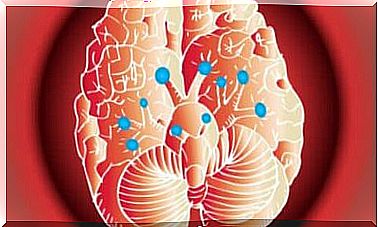How Does The Brain Treat The Feeling Of Disgust?

Treating the feeling of disgust is one of man’s most basic functions and has kept the species alive for centuries. Although it is in a way forgotten by psychology, there is already enough information available on how the brain does this. We can define disgust as a feeling of strong distaste for certain objects or substances. It makes you want to expel, distance yourself from or simply reject it.
This feeling is universal and recognized as one of the six fundamentals, which are common in all cultures and even in those with sensory limitations. It comes with a distinctive facial expression. For example, there is an elevation of the upper lip, a wrinkle and a lowering of the lips.
In addition, the feeling of disgust usually comes with a reduction in tension, a reduction in galvanic skin response, nausea, a reduction in heart rate, a feeling of reluctance, distancing from the object, respiratory changes and characteristic expressions such as “Aww!”

Feeling disgust and its nature
You have to keep in mind that experience dictated the model for the human brain both as a species and individually. Even though you may not know it, humans had a kind of immune system for behavior before it evolved into the sophisticated one we have today.
The said basic system was used as a barrier that protected humans from contact with parasites and other potential dangers.
The benefit of treating disgust is mainly about avoiding illness. Although there are cultural differences around what disgusts people, the main things that trigger this feeling are:
- Secretions and certain body parts : feces, saliva, blood, wounds, vomiting, dirty feet, etc.
- Rotten food.
- Insects, worms and spiders.
- Certain characteristics of strangers or those who are different.
- Violation of certain social and moral norms.
As innate as this feeling is, keep in mind that people acquire certain aspects of it that make them feel disgusted. This is where cultural and developmental differences are evident. For example, children up to the age of two do not seem to know what disgust is.
However, one can explain this by saying that they are still in the care of the parents. Mainly because the human species is quite immature and vulnerable in the first years of life. Thus, young children eventually develop this feeling by observing their parents’ behavior.
The brain and how it treats the feeling of disgust
To know how your brain treats disgust, you must first consider two regions: the insula and the limbic system (the tonsils and the hippocampus).
The insula receives information from the sensory pathways and sends information or stimuli to other structures, such as the limbic system, the ventral striatum and the cortex orbitofrontalis in the forehead lobe. This region seems to be responsible for experiencing disgust, as well as for recognizing expressions of disgust in other people.
For example, Cortex insularis in people with Huntington’s disease does not work properly, so they have difficulty experiencing this feeling. In addition, stimulation of the Cortex insularis leads to nausea.
The limbic system, and specifically the amygdala, is related to negative emotional processing, such as fear, disgust and learning. In fact, a group formed by members of the University of Granada and the Autonomous University of Baja California recently discovered the specific region of the tonsils that causes rejection of unpleasant tastes.
To treat disgust
Until now, scientific studies claimed that disgust was part of certain areas of the brain, and took pictures of the areas they thought were involved. Now, thanks to new technologies, such as functional magnetic resonance imaging, one can clearly see how the brain treats disgust dynamically.
About a year ago, a group of researchers from Catalonia exposed 30 people to a study. In it, they presented a six-minute video that contained pictures of many appetizing dishes. They also showed another who had pictures of food next to other unpleasant things like cockroaches, people eating worms, etc.
The results revealed that the brain still processes this feeling 40 seconds after looking at the unpleasant images. In addition, the images of the brain showed that not only activates a part of the brain in the face of a disgusting scene or object, but almost half of it.
When it comes to studies of disgust, researchers say that there are three stages:
- A stimulus appears and the brain begins to activate the body’s defense and protection mechanisms, even without being aware of it.
- The second phase is a conscious awakening after the brain considers a stimulus as consciously negative.
- Finally, there is the third phase of assimilation where a person experiences disgust and stores it in memory for future reference. This phase can last for about 26 seconds.

Disorders of feeling disgust
You may feel extreme disgust at some stimuli that did not bother you in the first place. Thus, there are several psychopathological disorders that are either related or at least have a disgusting component.
There are some examples of anxiety disorders such as bipolar disorder or obsessive-compulsive disorder where there is great concern about the spread of bacteria and dirt.
The component of disgust is crucial in some phobias such as hemophobia or social phobia. As for the latter, it seems that some people feel disgust, or a certain reluctance to associate with people. The role of the feeling of disgust in eating disorders is still under investigation.









